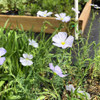Linum lewisii - Appalachian Strain from W. Virginia - PRAIRIE FLAX
Clump forming, airy-slender perennial with up to 1" pale blue to whitish flowers, strain from isolated population from West Virginia.
Narrow, grayish toned leaves, each stem bears several flowers, that start to bloom from the bottom and continues on the top, followed by round-balloon seed capsules.
Stems are 18-20" tall, usually a bit leaning towards one side - especially on more rich or moist soils.
This is native wildflower to the western 3/4 of North America, from Alaska and subarctic Canada as far south to northern Mexico, with only one rare isolated population in West Virginia and this is from where our plants originate.
This brings thought, that this plant was present in larger area, before it was pushed away by the glacier.
See the USDA distribution map.
Full sun, average, but drained soils, shallow, rocky, sandy soils, poor infertile soils, limestone barrens, gravelly soils. The drier the soil is, the longer-lived the plants get, but generally, this is short-lived perennial that reseeds.
Flowers for long time, from May to August, with the peak in early summer.
Deer resistant, hardy in zones 3 to 9.
Prairie flax (or Lewis flax, blue flax or wild blue flax) is attracts wide range of native bees and small flies and is recommended by Xerxes society.
Native Americans used it as herb - eyewash boils, poultice of fresh crushed leaves applied to irritated eyes, to improve hair and as important fiber-cloth plant.
For dry flower beds, rock gardens, shallow soils, naturalization in dry soil, dry prairies, this is very good filler in flower bed, because the color of five-petaled flowers goes well with many other colors. Seed capsules can be dried and used for dry flower arrangements.
Combine with Coreopsis, Gaillardia, Paeonia, Papaver orientale, Monarda bradburyana, Penstemon (especially with purple or reddish flowers), Nepeta, Salvia nemorosa, Salvia x sylvestris hybrids, Stachys byzantina, Sedum, and lower grasses.
Picture copyright : US Perennials nursery
Pot size : square 3.5" x 4" deep perennial pot

Linum lewisii - Appalachian Strain from W. Virginia - PRAIRIE FLAX
Clump forming, airy-slender perennial with up to 1" pale blue to whitish flowers, strain from isolated population from West Virginia.
Narrow, grayish toned leaves, each stem bears several flowers, that start to bloom from the bottom and continues on the top, followed by round-balloon seed capsules.
Stems are 18-20" tall, usually a bit leaning towards one side - especially on more rich or moist soils.
This is native wildflower to the western 3/4 of North America, from Alaska and subarctic Canada as far south to northern Mexico, with only one rare isolated population in West Virginia and this is from where our plants originate.
This brings thought, that this plant was present in larger area, before it was pushed away by the glacier.
See the USDA distribution map.
Full sun, average, but drained soils, shallow, rocky, sandy soils, poor infertile soils, limestone barrens, gravelly soils. The drier the soil is, the longer-lived the plants get, but generally, this is short-lived perennial that reseeds.
Flowers for long time, from May to August, with the peak in early summer.
Deer resistant, hardy in zones 3 to 9.
Prairie flax (or Lewis flax, blue flax or wild blue flax) is attracts wide range of native bees and small flies and is recommended by Xerxes society.
Native Americans used it as herb - eyewash boils, poultice of fresh crushed leaves applied to irritated eyes, to improve hair and as important fiber-cloth plant.
For dry flower beds, rock gardens, shallow soils, naturalization in dry soil, dry prairies, this is very good filler in flower bed, because the color of five-petaled flowers goes well with many other colors. Seed capsules can be dried and used for dry flower arrangements.
Combine with Coreopsis, Gaillardia, Paeonia, Papaver orientale, Monarda bradburyana, Penstemon (especially with purple or reddish flowers), Nepeta, Salvia nemorosa, Salvia x sylvestris hybrids, Stachys byzantina, Sedum, and lower grasses.
Picture copyright : US Perennials nursery
Pot size : square 3.5" x 4" deep perennial pot


